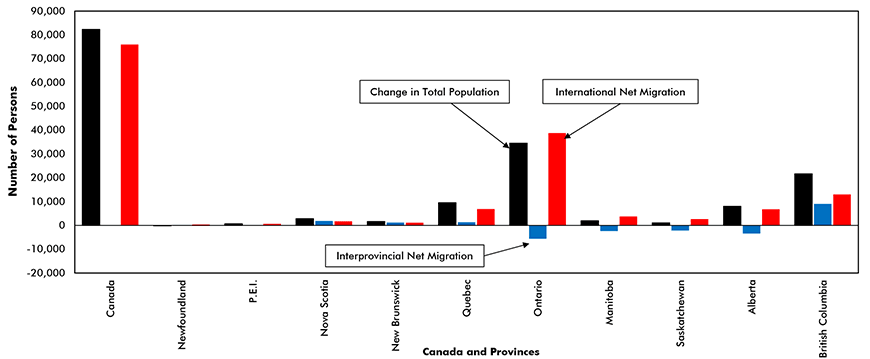Against the ongoing headwind of COVID-19, Canada is attracting more international migrants. Also, more Canadians are choosing to move to another province. After a gain of 34,000 individuals in the final quarter of 2020, the number of international migrants more than doubled to 76,000 in the first quarter of this year. This increase exceeded the 70,000 who arrived in Canada in Q1/2020 but it fell short of the 83,000 who entered the country in the first quarter of 2019.
The solid gain in net international migration was partly offset by a below-average increase in births and an above-average number of deaths, due to COVID-19. Consequently, Canada’s total population edged up by +0.9% q/q (at an annual rate) in Q1/21 following an increase of +0.4% in Q4/2020.
Interprovincial migration shifts to higher gear in Q1
The slight reduction, from 74,400 to 72,000, in the number of Canadians who moved to another province in the first quarter of this year compared to the first quarter of 2020 suggests that persisting restrictions on travel in the wake of the second wave of COVID-19 continued to exert a drag on interprovincial migration. Looking forward, the gradual relaxation of COVID-19 travel restrictions, together with record high levels of consumer confidence, suggest that interprovincial migration will accelerate during the remainder of this year and into 2022.
Ontario attracts more than half of all international migrants
In Ontario, a net inflow of 39,000 international migrants (over half the national total), a natural increase of 1,400, and a net outflow of 5,600 residents to other provinces, caused the province’s population to rise by an estimated 35,000 in the first quarter following a gain of 22,000 in the final quarter of 2020. International in-migration accelerated in the second quarter despite the onset of the third wave of COVID-19. In June, the province admitted a record 18,700 permanent residents, 14,000 of whom decided to live in Toronto. Three-quarters (75%) of the permanent residents who have moved to Ontario over the past two years have settled in Toronto.
Interprovincial migrants still stream to B.C.
Although COVID-19 briefly interrupted the flow of international migration into British Columbia during the second and third quarters of 2020, the province has remained the go-to destination for most Canadians who have wanted to relocate to another province. While it may have been the case that fewer Canadians moved to another province in this year’s first quarter, that didn’t stop B.C. from making a resident count pickup. Following a net gain of 4,900 in the final quarter of 2020, B.C.’s net interprovincial migration hit a 27-year high of 9,000 in the first quarter of 2021. At the same time, net international migration jumped to 13,000 from 3,400 in Q4/2020.
Due to the solid 22,000 gain in total net migration and despite a slight 300 decline in natural increase, B.C.’s population growth accelerated from +0.6% q/q at an annual rate in Q4/2000 to +1.7% in Q1/2021, second only to Prince Edward Island’s +1.8%. Since it has attracted 80% of B.C.’s international migrants, Vancouver’s appeal to those from outside the country appears to outweigh that of Toronto’s.
Quebec’s year-to-date admissions beat pre-COVID-19
After a drop of -4,200 persons in Q3/2020 due to COVID-19 travel restrictions, Quebec attracted 500 international migrants in Q4/2020 and a further 7,000 in the first quarter of this year. This increase, together with net interprovincial migration totaling 1,300 and a natural increase of 1,300, caused the province’s total population to increase by +0.4% q/q annualized following no change in Q4 2020. As with Toronto in Ontario and Vancouver in B.C., Montreal within Quebec is the preferred destination of the majority of newly admitted permanent residents. Over the past six months, 81.4% of the 15,700 individuals admitted to Quebec as permanent residents chose to locate in the country’s 2nd-largest city.
No full migration recover until mid-2023
The increasing case counts of the highly contagious COVID-19 Delta variant will probably restrict the flow of both international and interprovincial migrants through the rest of 2021, and perhaps even as far ahead as into 2023. However, the negative impact of the virus on net migration into the country should be partly offset by recently announced measures by several provinces and by the federal government to encourage everyone to become vaccinated.
Since the total number of admissions of permanent residents year to date (June) stands at 144,700 and given the lingering impediments to both international and interprovincial mobility due to the coronavirus and its variants, we expect net international migration will total in the range of 300,000 to 350,000 this year. Next year, assuming an increase in vaccine penetration and fewer restrictions on international travel, the net inflow of international migration should approach, but will not likely fully reach, the federal government’s recently announced target of 411,000.
John Clinkard has over 35 years’ experience as an economist in international, national and regional research and analysis with leading financial institutions and media outlets in Canada.
Net change in total population, interprovincial and international migration – Canada and provinces in Q1/2021

Chart: ɫ��ɫ – CanaData.
Please click on the following link to download the PDF version of this article:


Recent Comments
comments for this post are closed